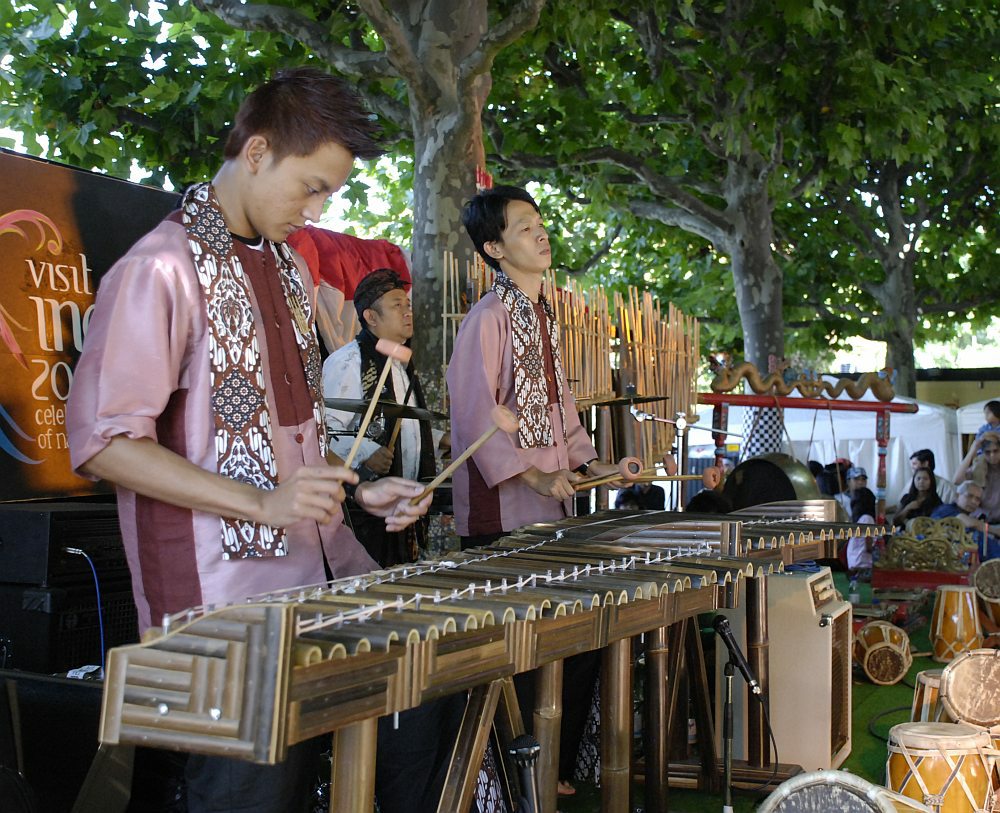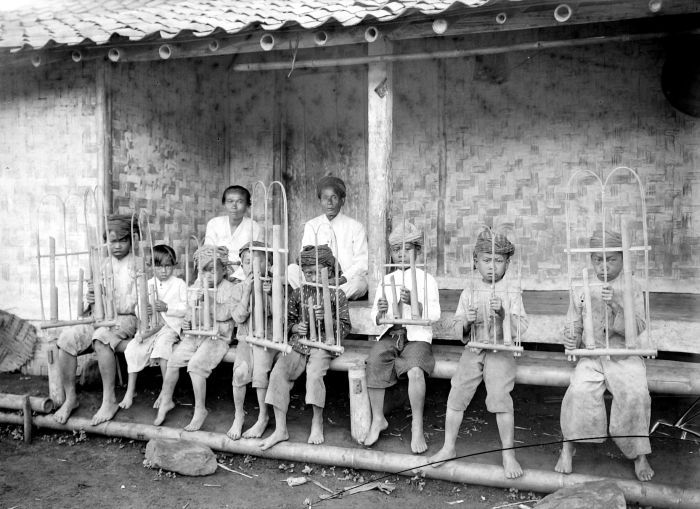|
Calung
The ''calung'' ( su, ) is a type of Indonesian bamboo xylophone originating from Baduy culture and commonly used in Baduy, Bantenese, Sundanese, Banyumasan, and Balinese performances. The calung (instrument) consists of multiple bamboo tubes which are struck at the base to produce a woody sound. In the Balinese Gamelan gong kebyar, the metallophone Jublag can also be known as ''Calung'', it has a one-octave range, and is generally utilized to play mid-range melodies. In Banyumas, southwestern Central Java in Indonesia, when Calung is referred to as an ensemble, it uses multiple bamboo instruments and is composed of singers and dancers. (2007). The ensemble is characterized by a variety of traits that include: interlocking melodies and |
Banyumasan People
Banyumasan or Banyumasan Javanese ( Javanese: Ngoko: (''Wòng Banyumasan''), Indonesian: ''Orang Banyumasan'') (colloquially known as Javanese Ngapak) is a collective term for a Javanese subgroup native to the Indonesia's westernmost part of Central Java. At approximately ±9 million people, they are concentrated in Banyumas, Cilacap, Kebumen, Purworejo, Purbalingga, and Banjarnegara regencies. The Banyumasan-Javanese speak Banyumasan dialect of Javanese language, a dialect which is often called "''basa ngapak-ngapak''". History Hindu-Buddhist kingdoms era In the first era of Hindu-Buddhist in Indonesia, Banyumasan region divided into Tarumanagara Kingdom's influence in the west and Kalingga Kingdom's influence in the east with Cipamali river or "''Kali Brebes''" as natural borders. The other Hindu-Buddhist Kingdoms that influenced this region is Galuh Kingdom, Mataram Kingdom, Kediri Kingdom, Singhasari Kingdom and Majapahit Empire. After the decline of Majapahit, Ban ... [...More Info...] [...Related Items...] OR: [Wikipedia] [Google] [Baidu] |
National Intangible Cultural Heritage Of Indonesia
Intangible Cultural Heritage of Indonesia is a "living culture" that contains philosophical elements from the traditions of society and is still handed down from generation to generation. Edi Sedyawati (in the introduction to the Intangible Cultural Heritage Seminar, 2002) added an important element in the notion of intangible cultural heritage is the nature of culture that cannot be held (abstract), such as concepts and technology, its nature can pass and disappear in time with the times such as language, music, dance, ceremony, and various other structured behaviors. Thus, cultural heritage is shared by a community or community and experiences development from generation to generation, in the flow of a tradition. The Ministry of Education and Culture of Indonesia records and establishes a list of intangible cultural heritage. As of June 2020, a total of 9,770 cultural heritages have been recorded and 1,086 of them have been designated. Law The legal basis for the activities ... [...More Info...] [...Related Items...] OR: [Wikipedia] [Google] [Baidu] |
West Java
West Java ( id, Jawa Barat, su, ᮏᮝ ᮊᮥᮜᮧᮔ᮪, romanized ''Jawa Kulon'') is a province of Indonesia on the western part of the island of Java, with its provincial capital in Bandung. West Java is bordered by the province of Banten and the country's capital region of Jakarta to the west, the Java Sea to the north, the province of Central Java to the east and the Indian Ocean to the south. With Banten, this province is the native homeland of the Sundanese people, the second-largest ethnic group in Indonesia. West Java was one of the first eight provinces of Indonesia formed following the country's independence proclamation and was later legally re-established on 14 July 1950. In 1966, the city of Jakarta was split off from West Java as a 'special capital region' (), with a status equivalent to that of a province, while in 2000 the western parts of the province were in turn split away to form a separate Banten province. Even following these split-offs, West Java ... [...More Info...] [...Related Items...] OR: [Wikipedia] [Google] [Baidu] |
Music Of Sunda
Sundanese Music ( Sundanese: ) is an umbrella term that encompasses diverse musical traditions of the West Java and Banten in western part of Java, Indonesia. The term of "West Java" is preferred by scholars in this field. The word "Sundanese" originally referred to western part of Java Island and has a strong association with the highly centralized Sunda Kingdom based on Java Island and its high culture practiced by the nobleman class in its capital Parahyangan. By contrast, scholars who cover a much broader region lay emphasis on folk culture. The people of Sundanese, who inhabit the Westernmost third of the island of Java, are sometimes wrongly referred to by foreigners as Javanese. Sundanese culture, language and music are quite distinct from those of the Javanese people of Central and East Java - although of course there are also elements in common. In Sunda there is a bewildering diversity of musical genres, musical composition and tuning systems are recognizably di ... [...More Info...] [...Related Items...] OR: [Wikipedia] [Google] [Baidu] |
Indonesia
Indonesia, officially the Republic of Indonesia, is a country in Southeast Asia and Oceania between the Indian and Pacific oceans. It consists of over 17,000 islands, including Sumatra, Java, Sulawesi, and parts of Borneo and New Guinea. Indonesia is the world's largest archipelagic state and the 14th-largest country by area, at . With over 275 million people, Indonesia is the world's fourth-most populous country and the most populous Muslim-majority country. Java, the world's most populous island, is home to more than half of the country's population. Indonesia is a presidential republic with an elected legislature. It has 38 provinces, of which nine have special status. The country's capital, Jakarta, is the world's second-most populous urban area. Indonesia shares land borders with Papua New Guinea, East Timor, and the eastern part of Malaysia, as well as maritime borders with Singapore, Vietnam, Thailand, the Philippines, Australia, Palau, and India ... [...More Info...] [...Related Items...] OR: [Wikipedia] [Google] [Baidu] |
Music Of Indonesia
As it is a country with many different tribes and ethnic groups, the music of Indonesia ( id, Musik Indonesia) itself is also very diverse, coming in hundreds of different forms and styles. Every region have its own culture and art, and as a result traditional music from area to area also uniquely differs from one another. For example, each traditional music are often accompanied by their very own dance and theatre. Contemporary music scene have also been heavily shaped by various foreign influences, such as America, Britain, Japan, Korea, and India. The music of Java, Sumatra, Bali, Flores (Lesser Sunda Islands) and other islands have been well documented and recorded, and further research by Indonesian and international scholars is also ongoing. The music in Indonesia predates historical records, various Native Indonesian tribes often incorporate chants and songs accompanied with musical instruments in their rituals. The contemporary music of Indonesia today is also popula ... [...More Info...] [...Related Items...] OR: [Wikipedia] [Google] [Baidu] |
Masterpieces Of The Oral And Intangible Heritage Of Humanity
The Proclamation of Masterpieces of the Oral and Intangible Heritage of Humanity was made by the Director-General of UNESCO starting in 2001 to raise awareness of intangible cultural heritage and encourage local communities to protect them and the local people who sustain these forms of cultural expressions. Several manifestations of intangible heritage around the world were awarded the title of ''Masterpieces'' to recognize the value of the non-material component of culture, as well as entail the commitment of states to promote and safeguard the Masterpieces. Further proclamations occurred biennially. In 2008, the 90 previously proclaimed Masterpieces were incorporated into the new Representative List of the Intangible Cultural Heritage of Humanity as its first entries. Background UNESCO defines oral and intangible heritage as "the totality of tradition-based creations of a cultural community expressed by a group or individuals and recognized as reflecting the expectations of a ... [...More Info...] [...Related Items...] OR: [Wikipedia] [Google] [Baidu] |
UNESCO
The United Nations Educational, Scientific and Cultural Organization is a specialized agency of the United Nations (UN) aimed at promoting world peace and security through international cooperation in education, arts, sciences and culture. It has 193 member states and 12 associate members, as well as partners in the non-governmental, intergovernmental and private sector. Headquartered at the World Heritage Centre in Paris, France, UNESCO has 53 regional field offices and 199 national commissions that facilitate its global mandate. UNESCO was founded in 1945 as the successor to the League of Nations's International Committee on Intellectual Cooperation.English summary). Its constitution establishes the agency's goals, governing structure, and operating framework. UNESCO's founding mission, which was shaped by the Second World War, is to advance peace, sustainable development and human rights by facilitating collaboration and dialogue among nations. It pursues this objectiv ... [...More Info...] [...Related Items...] OR: [Wikipedia] [Google] [Baidu] |
Tempo
In musical terminology, tempo ( Italian, 'time'; plural ''tempos'', or ''tempi'' from the Italian plural) is the speed or pace of a given piece. In classical music, tempo is typically indicated with an instruction at the start of a piece (often using conventional Italian terms) and is usually measured in beats per minute (or bpm). In modern classical compositions, a " metronome mark" in beats per minute may supplement or replace the normal tempo marking, while in modern genres like electronic dance music, tempo will typically simply be stated in BPM. Tempo may be separated from articulation and meter, or these aspects may be indicated along with tempo, all contributing to the overall texture. While the ability to hold a steady tempo is a vital skill for a musical performer, tempo is changeable. Depending on the genre of a piece of music and the performers' interpretation, a piece may be played with slight tempo rubato or drastic variances. In ensembles, the tempo is ofte ... [...More Info...] [...Related Items...] OR: [Wikipedia] [Google] [Baidu] |
Rhythm
Rhythm (from Greek , ''rhythmos'', "any regular recurring motion, symmetry") generally means a " movement marked by the regulated succession of strong and weak elements, or of opposite or different conditions". This general meaning of regular recurrence or pattern in time can apply to a wide variety of cyclical natural phenomena having a periodicity or frequency of anything from microseconds to several seconds (as with the riff in a rock music song); to several minutes or hours, or, at the most extreme, even over many years. Rhythm is related to and distinguished from pulse, meter, and beats: In the performance arts, rhythm is the timing of events on a human scale; of musical sounds and silences that occur over time, of the steps of a dance, or the meter of spoken language and poetry. In some performing arts, such as hip hop music, the rhythmic delivery of the lyrics is one of the most important elements of the style. Rhythm may also refer to visual presentation, as "timed ... [...More Info...] [...Related Items...] OR: [Wikipedia] [Google] [Baidu] |
Central Java
Central Java ( id, Jawa Tengah) is a province of Indonesia, located in the middle of the island of Java. Its administrative capital is Semarang. It is bordered by West Java in the west, the Indian Ocean and the Special Region of Yogyakarta in the south, East Java in the east, and the Java Sea in the north. It has a total area of 32,800.69 km2, with a population of 36,516,035 at the 2020 Census making it the third-most populous province in both Java and Indonesia after West Java and East Java. The official estimate as at mid 2021 was 36,742,501.Badan Pusat Statistik, Jakarta, 2022. The province also includes the island of Nusakambangan in the south (close to the border of West Java), and the Karimun Jawa Islands in the Java Sea. Central Java is also a cultural concept that includes the Yogyakarta Special Region, in turn including the city of Yogyakarta; however, administratively that city and its surrounding regencies have formed a separate special region (equiv ... [...More Info...] [...Related Items...] OR: [Wikipedia] [Google] [Baidu] |
Metallophone
A metallophone is any musical instrument in which the sound-producing body is a piece of metal (other than a metal string), consisting of tuned metal bars, tubes, rods, bowls, or plates. Most frequently the metal body is struck to produce sound, usually with a mallet, but may also be activated by friction, keyboard action, or other means. Metallophones have been used in music in Asia for thousands of years. There are several different types used in Balinese and Javanese gamelan ensembles, including the gendér, gangsa and saron. These instruments have a single row of bars, tuned to the distinctive pelog or slendro scales, or a subset of them. The Western glockenspiel and vibraphone are also metallophones: they have two rows of bars, in an imitation of the piano keyboard, and are tuned to the chromatic scale. In music of the 20th century and beyond, the word ''metallophone'' is sometimes applied specifically to a single row of metal bars suspended over a resonator box. Metalloph ... [...More Info...] [...Related Items...] OR: [Wikipedia] [Google] [Baidu] |






.jpg)
